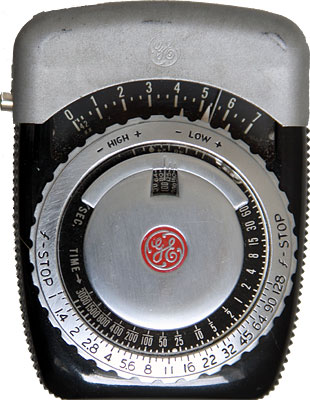
|
  Maker: General Electric Model: PR-1 Circa: 1948 Designer:Allen Stimson US Patents:2,483,945; 2,501,547; 2,648,254 Price (new): $28 Cell type: Selenium Measure type: Reflecting/Averaging; 2D incident with attachment |
|
The PR-n series was a big departure for GE. Up until now, their meters had all been very simple. The DW-40 was a simple meter-in-a-box with a frosted window over the cell. The DW-47 added an extended cover and a hinged high/low level door on the end. Subsequent DWs were just minor variations of that format. But this was all new. It was smaller than the DWs, designed to fit into the palm of the hand, with a small meter window on top and a very large calculator dial in the center. The big feature is what marketing called "the meter with a memory!" aka needle lock. This is the oldest meter I've seen with that feature, so it may be the first. Needle locks hold the needle in place until you release it for a reading, and then holds it again. For the photographer, it allows you to point the meter for a reading, then look at the meter in a more comfortable position. I believe that holding the needle down also protects it a little from bumps and shocks. Another feature is the internal high-low range setup. It uses a mechanical system to limit the light (as opposed to using electronics to change the readings) in the form of a shutter between the photo cell and the window. When set to High, the shutter is partially closed and limits the amount of light. When Low, the shutter is opened to let in more light. Most other meters required the user to physically change something, like moving the baffle on the Weston Masters, dropping a perforated slide over the cell on a Norwood Director, or swinging a door open (or shut) as on the GE DW series or the Sekonic L-VI. On this one you just turn the dial and it switches automatically when you reach one end of the range or the other. But really, the most important feature was the Trident Analyzer and the top of the dial, which was GE's version of Weston's UACO marks, and it anticipates the match-needle systems that took over in the 1960s. Under normal conditions, you'd match the middle tine of the trident against the needle position. The left side tine was 1-stop overexposed, the right side tine was 1-stop under. Further markings the dial allowed you to read and evalulate contrast ranges, if you were so inclined. There were two tridents: one for Low and one for High, and they switched when you changed ranges. It was really a nice little set up. One final thing to note: the needle release button is on the left-hand side, and every illustration shows the meter being held in the left hand (with the thumb over the button). I don't know whether the designer was left-handed or if they had some special reason to do it, but it's not mentioned anywhere in the manual. Every other meter I've seen is oriented for right-handed users. How to use it: first set the film speed (which is shown in the window in the 12 o'clock position of the calculator dial). Look for a little tab on the black ring of the calculator dial, located around the 8 o'clock position. Use that tab to rotate the dial and set the film speed in the window. Use the GE film speed scale, not ASA. Once the film speed is set, it's easy. Hold the meter about chest-high and aim at your subject. Press the button on the side which will unlock the needle. Turn the outer ring of the calculator dial and you should see another pointer move on the meter face; move the pointer until it aligns with the needle. Now you can let go of the pointer and read the shutter-speed/aperture combinations on the bottom of the calculator dial. This meter has two ranges, high and low, and everything's done internally. There's no accessory to plug in or baffle to flip open or closed. |
|
©opyright by James Ollinger. All Rights Reserved.
Company names and models are registered trademarks of their respective owners
and are not affiliated with this website in any way.

s.jpg)